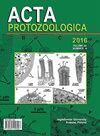Achradina pulchra, a Unique Dinoflagellate (Amphilothales, Dinophyceae) with a Radiolarian-like Endoskeleton of Celestite (Strontium Sulfate)
IF 1.2
4区 生物学
Q4 MICROBIOLOGY
引用次数: 1
Abstract
We examined the planktonic dinoflagellate Achradina pulchra by light and scanning electron microscopies from the South and North Atlantic oceans. The basket-like skeleton has been interpreted as a thick cell covering or pellicle of organic composition, or as a siliceous endoskeleton. The skeleton of Achradina is known only from fresh material, being absent in preserved samples, sediments or the fossil record. X-ray microanalysis revealed that the endoskeleton of Achradina is composed of celestite (strontium sulfate) with traces of barite (barium sulfate), two minerals that readily dissolve after cell death. To date, Acantharia and polycystine radiolarians (Retaria) were the only known organisms with a skeleton of this composition. We can now add a dinoflagellate to the list of such mineralized skeletons, which influence on the biogeochemical fluxes of strontium and barium in the oceans. Moreover, we provided the first molecular data for a skeleton-bearing dinoflagellate. Molecular phylogeny based on the SSU rRNA gene sequences revealed that Achradina and several environmental clones branched as an independent lineage within the short-branching dinokaryotic dinoflagellates. To date, seven clades of dinokaryotic dinoflagellates are known living as symbionts in the endoplasm of Acantharia and polycystine radiolarians. Because celestite built skeletons were unknown outside radiolarians, we suggested that the ancestors of Achradina acquired the genes implicated in the deposition of strontium and barium from radiolarian hosts though a horizontal gene transfer event between microbial eukaryotes.长柄Achradina pulchra,一种独特的甲藻目(两栖目,藻科),具有类似放射虫的天青石内骨架(硫酸锶)
我们通过来自南大西洋和北大西洋的光学和扫描电子显微镜检查了浮游甲藻Achradina pulchra。篮状骨架被解释为有机成分的厚细胞覆盖物或薄膜,或硅质内骨架。Achradina的骨骼仅从新鲜材料中得知,在保存的样本、沉积物或化石记录中都没有。X射线显微分析显示,阿克拉迪纳的内骨骼由天青石(硫酸锶)和微量重晶石(硫酸钡)组成,这两种矿物在细胞死亡后很容易溶解。迄今为止,Acantharia和polycystine radiarians(Retaria)是唯一已知的具有这种组成骨架的生物。我们现在可以将甲藻添加到此类矿化骨骼的列表中,这会影响海洋中锶和钡的生物地球化学通量。此外,我们还提供了第一个携带甲藻骨架的分子数据。基于SSU rRNA基因序列的分子系统发育研究表明,Achradina和几个环境克隆作为一个独立的谱系在短分支的甲藻中分支。迄今为止,已知有七个底核甲藻分支作为共生体生活在Acantharia和polycystine放射虫的细胞质中。由于天青石建造的骨骼在放射虫之外是未知的,我们认为Achradina的祖先通过微生物真核生物之间的水平基因转移事件从放射虫宿主获得了与锶和钡沉积有关的基因。
本文章由计算机程序翻译,如有差异,请以英文原文为准。
求助全文
约1分钟内获得全文
求助全文
来源期刊

Acta Protozoologica
生物-微生物学
CiteScore
2.00
自引率
0.00%
发文量
8
审稿时长
>12 weeks
期刊介绍:
Acta Protozoologica - International Journal on Protistology - is a quarterly journal that publishes current and comprehensive, experimental, and theoretical contributions across the breadth of protistology, and cell biology of Eukaryote microorganisms including: behaviour, biochemistry and molecular biology, development, ecology, genetics, parasitology, physiology, photobiology, systematics and phylogeny, and ultrastructure. It publishes original research reports, critical reviews of current research written by invited experts in the field, short communications, book reviews, and letters to the Editor.
 求助内容:
求助内容: 应助结果提醒方式:
应助结果提醒方式:


